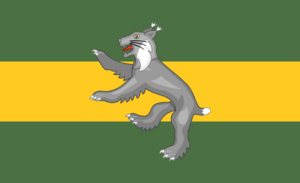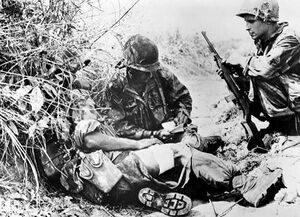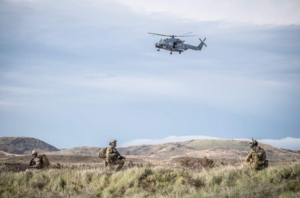Royal Easthampton Borderers: Difference between revisions
| Line 82: | Line 82: | ||
[[Category:Military]] | [[Category:Military]] | ||
[[Category:Military units]] | [[Category:Military units]] | ||
[[Category:2023 Award winning pages]] | |||
[[Category:IXWB]] | [[Category:IXWB]] | ||
Revision as of 08:57, 31 May 2023
| Royal Easthampton Borderers | |
|---|---|
| REB | |
 | |
| Active | 1890 |
| Country | Arcerion |
| Type | |
| Role | Infantry |
| Size | 1,800 (2026) |
| Part of | 7 Rifle Brigade |
| Garrison/HQ | Larton Barracks, Arcerion Armed Forces Base Easthampton |
| Motto(s) | "Grit and Wit" |
| Engagements | Arcer Bush Wars, First Great War, Second Great War, Final War of the Deluge, Telekonese Conflict, Istrenyan Crisis |
| Commanders | |
| Commanding Officer | LCol Christian MacNulty |
| Regimental Sergeant Major | WO1 Colin O'Lyne |
The Royal Easthampton Borderers is a light infantry regiment of the Arcer Army's Royal Arcerion Infantry Corps. It consists of a number of battalions and garrison units, split amongst both the Regular Force and Reserve/Territorial troops. Each of the Regiment's battalions form part of 7 Rifle Brigade, which is Arcerion's premier light infantry brigade. The Borderers focus on tasks such as mountaineering, air assault, pathfinding, long-range reconnaissance, individual marksmanship, and long-distance patrolling. The Regiment was created in 1890 after an amalgamation of the Easthampton Regiment and the Arcerion Easthampton Borderers, and has remained in its current configuration since it amalgamated the Arcerion highland Infantry Regiment which disbanded and re-badged to the Borderers in 1919. The Borderers are widely considered in Arcerion to be the premier light infantry Regiment in the Army, and are respected in Crona and Ixnay as world-class experts in alpine warfare and dismounted infantry operations.
The Regiment is headquartered at the Larton Barracks, Arcerion Armed Forces Base Easthampton.
History
Early History
The Regiment was stood up in 1890, when the Arcer General Staff released orders to collapse the two existing regiments in the eastern part of Moorden Governorate into a singular formation. The existing Eashampton Regiment, initially formed in 1840, as well as the Arcerion Easthampton Borderers which had been stood up in 1867 were collapsed and given the honorific 'Royal,' owing to their exemplary service policing the border areas in Washakara. The Regiment participated in the Third Bush War, helping to secure frontier settlements and battle native incursions into the Arcer Heartland.
The Regiment saw major action in the Defense of Easthampton during the First Great War, where it defended the city of Easthampton from Paulastran troops, and was engaged heavily in trench warfare and modern methods of fighting, including the use of modern machineguns, infantry mortars, and early wireless radio sets. Shortly after the end of the First Great War, the Arcer General Staff began to disband the total amount of Regular Army infantry units, and two battalions from the Arcerion Highland Infantry Regiment re-badged to the Borderers as part of this force restructuring.
Early Modern History

The Regiment deployed as part of the Arcer government's effort to aid the failing Royal Government of the Kingdom of Ardmore during the Ardmori Civil War. It participated in a number of battles against communist forces, and during the Battle of Elliston was awarded one of the final battle honours in the Arcer Army by the King of Ardmore for its successful assault against communist forces in the hills around the strategically important crossroads town. The Borderers played a key role during the withdrawal to the North Island during Operation Smatter (also called the Battle of the Southern Marches), where the 2nd and 4th battalions marched seventy kilometers while in close contact with the enemy.
During the Second Great War, the Borderers were heavily involved with the invasion of The Cape as part of Operation Lightfoot. The Regiment saw action throughout the duration of the conflict, and helped fight to the outskirts of Cape Town as part of Operation Severance. During this time, the Regiment's experience in complex terrain fighting helped immensely, as the mountainous and hilly terrain of the Southern portions of the Capetian peninsula made it difficult for fast-moving mechanized formations to maneuver, and the ground favoured elite mountain troops such as the Borderers. The Regiment withdrew in good order at the end of the war after two successful campaigns.
Occidental Cold War
The Borderers were assigned to 7 Rifle Brigade with its creation in 1960, assigned as one of three light infantry Regiments to the Brigade. Additionally, it was given additional funding, training and resources to stand up more light infantry capabilities. These notably included the introduction of new light machineguns, 60mm mortars, the first night division and STANO devices, modern VHF and UHF radios, and the creation of new facilities for mountaineer training. Notable among these was the creation of the Arcerion Mountain Warfare School, which the Borderers provided the staff and training cadre for, located in the town of Ashden in the Northumbraeland Mountains.

Shortly after the creation of 7 Rifle Brigade, it was hastily deployed across the Malentine Sea to fight communist and socialist forces in the Istrenyan Civil War. The Regiment's expertise in mountnain warfare once again assisted as 7 Rifle Brigade was assigned to fight in the mountains terrain with high elevation in South Istrenya. The Borderers conducted offensives, and utilised new technology to assist with the creation of modern methods for casualty extraction via helicopters. 7 Rifle Brigade's objective was Mogtopeni, a mountain town with the largest regional airport, which they were aiming to liberate to allow for the infiltration of 11 Parachute Brigade, who had staged in Chester-on-Moore awaiting a cleared drop zone.
The Borderers played a significant role at the Battle of M'Kelo Airport. The opening phases of the Battle heavily involved the 1st and 2nd Battalions, and they were unable to fully seize the objectives due to high volume of communist recoilless rifle and machinegun fire. On the morning of July 23rd, 7 Rifle Brigade took the airport in full. A follow-on air assault took place within the next 36 hours, and during the daylight hours on July 24th, 11 Parachute Brigade inserted onto the airfield to assist with the counter-offensive.
Telekonese Conflict
See Also: Operation Featherlite
The Regiment participated extensively in the Telekonese Conflict. It saw extensive action during the effort to retake the Gibson Gap during the 1986 Conflict, especially during the Battles at Larton and Gramsby. The Regiment suffered 42 casualties during the campaign, most of them from the 1st and 2nd Battalions during the engagements to liberate Sharnwick.
Post-2000s
Final War of the Deluge
2022 Confederate Memo on Defence
Regimental Symbols
The Regimental colours, yellow and green represent the Regiment's affiliation with green, the traditional colour of Arcerion, and the yellow represents the regimental dress uniform jacket facings from the Regiment's original red uniforms during the Third Bush War. The Lynx, a traditional mountain predatory animal, was chosen as the Regimental mascot and is represented on the Regimental colours. Commonly unofficial symbols often seen in the Regimental lines are crossed pickaxes, which shows an affiliation with Easthampton's steel mining industry, as well as a historical affiliation with alpine climbing tools.
The Regimental motto was adopted after the First Great War, where the Kinnaird Financial Times published an article after experiencing life in the trenches with 4th Battalion. It was quoted that "Arcer infantrymen from Easthampton maintain a surprising level of grit and wit during the horrible conditions in their fighting positions."
Structure and Role
The Regiment has maintained a similar structure since the amalgamation with the Arcerion Highland Infantry Regiment in 1919. A small restructure in 2022 after the release of the Confederate Memo on Defence means the current structure is as follows:

Regimental Headquarters, Royal Easthampton Borderers
- Regimental Museum
- Arcerion Mountain Warfare School (Ashden Detachment)
- Arcerion Marksmanship School Detachment (Presdale Detachment)
1st-5th Battalions, Royal Easthampton Borderers
- 3x Light Infantry Rifle Companies
- Combat Support Company
- Headquarters Company
6th & 7th Battalions, Royal Easthampton Borderers (Reserve)
- 2x Rifle Companies
- Headquarters Company
All five of the battalions operate in a light configuration and role within 7 Rifle Brigade, although some are cross-trained with infantry mobility vehicles and mine-resistant ambush protected vehicles (MRAPs). As part of the 2022 Confederate Memo on Defence, the Regiment will receive additional funding and equipment to further develop their light infantry and expeditionary capabilities, such as more light UAS, sniper weapons systems, new machineguns and man-portable anti-tank weapons, and more modern communications equipment. The Regiment also has a pair of Reserve Battalions, located in Chester-on-Moore and Port Hughes.
Traditions
The Regiment maintains a Halloween tradition on October 31st annually, where soldiers and their families conduct trick or treating at the Base Chapel on Arcerion Armed Forces Base Easthampton. This is a tradition since the Halloween 1986, where soldiers of the Regiment pooled candy, chocolate, and small gifts for the young children of the small Foxhey town of Sharnwick. The Borderers, in an attempt to improve the morale of the civilian populace, converted the local Catholic Church into a haunted house and handed out the gifts to families. The tradition has remained and is replicated every year both in Sharnwick, where the Regiment sends representatives, and at the Base Chapel for families of members of the Borderers.
The Regiment also has an annual ruck march competition named after the 'Long March at Larton.' Members of the Borderers, as well as other Arcer military servicemen and women and international allies compete in a 50km ruck march, where at the end there is a short marksmanship test. The gold medal is not awarded for fastest time, but rather for successful completion of the grueling physical test and marksmanship. Winner of the fastest time is awarded special honours by the Regiment, notably a small alpine axe trophy, as well as a judging position to help decide the next year's route for the march. Since the inception of the competition in 1990, the Borderers have won the fastest time all but six times.
Regimental Alliances
Stenz - something mountain y?
Burg, as always
Alstin